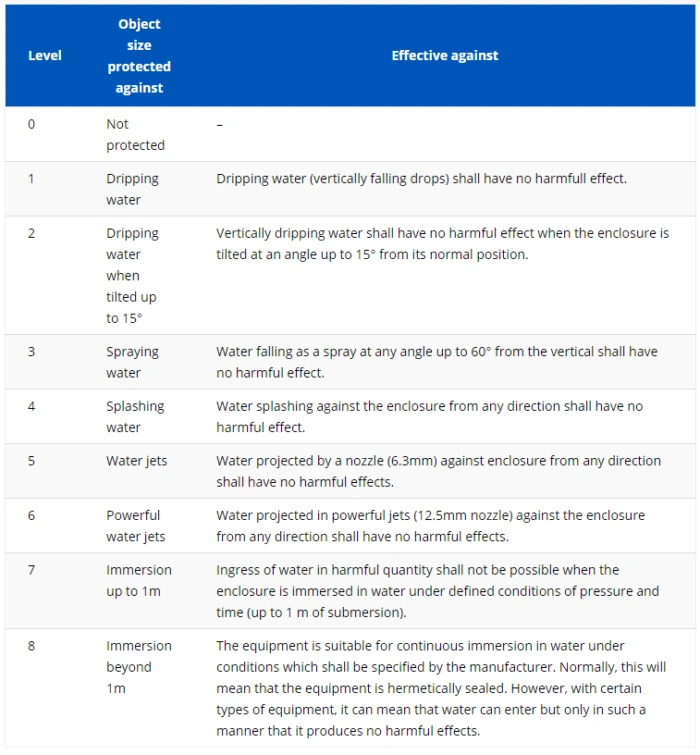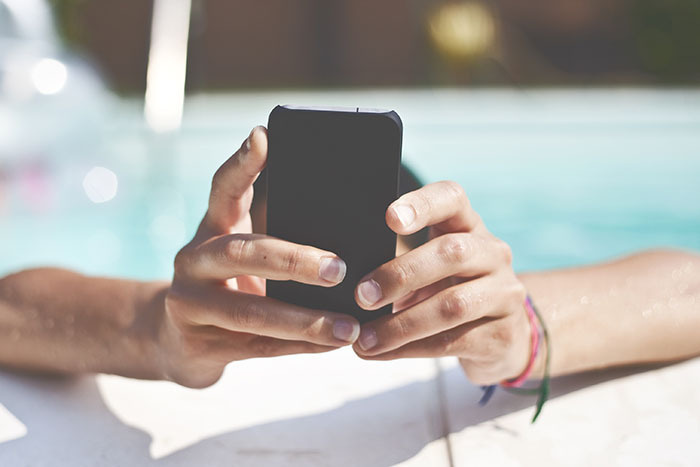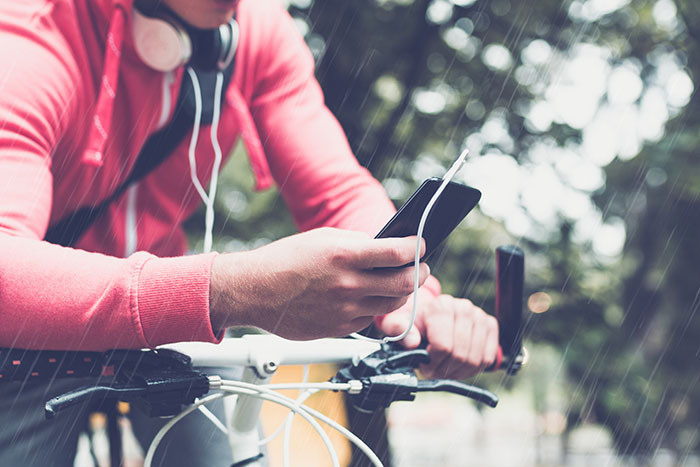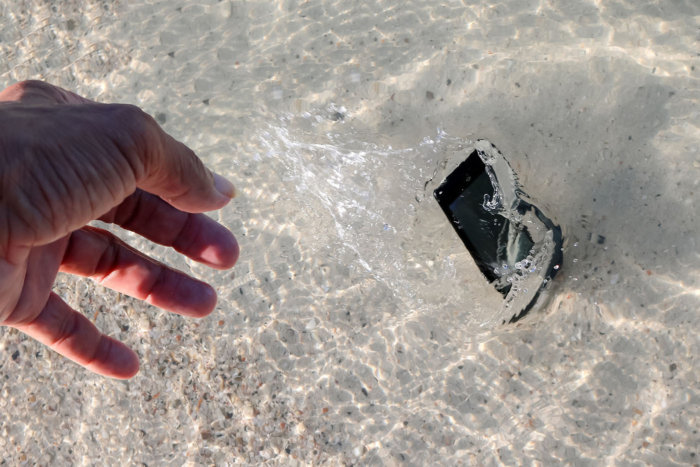Waterproof phones are exciting. Instead of dropping your phone in a bowl of rice when you accidentally knock it off the counter into the sink, you can just dry it off and keep trucking. And many of today’s waterproof phones are as watertight as possible. They’ve got an IP68 rating, where IP68 is the highest, barring extreme products that aren’t made for consumers. The waterproofness of a consumer device qualifies itself. Right?
The Samsung Galaxy S7 has an IP68 rating, the highest rating a consumer device can get on the IP scale. But that doesn’t mean you should take it surfing or white-water rafting. Here’s what those IP ratings really indicate.
Ingress Protection
First things first: What does “IP even stand for? Well, it actually stands for two things; International Protection and Ingress Protection. The IP code was created by the International Electrotechnical Commission (IEC). This non-profit, non-governmental organization creates international standards for all sorts of “electronic technology,” from semiconductors, batteries, home appliances, and smartphones.
The point of the IP code is to provide you, the customer, with detailed information about your device beyond just waterproof and not waterproof. Although the code’s standards can be pretty confusing. But the IP code aims to let you know whether your device will survive if you get caught in a torrential downpour or accidentally drop it in the pool.
What do the Numbers Mean?
The IP code has two numbers. The first number (0 – 6) indicates your device’s protection level against solid particles, which includes everything from large body parts to microscopic specks of dust. An IX rating, for example, means that your device is protected against fingers or similar objects. But anything smaller than a human finger might be able to get through and do some damage. On the other hand, an IP rating of IX means that your device is dust-tight. Even tiny bits of dust won’t end up inside the casing.
The second number indicates your device’s protection level against liquid, precisely, fresh water. This number ranges from 0 to 9, though no consumer smartphone is rated 9 or 6, for that matter. So the highest rating you’ll see here is an 8, meaning the device can be immersed in more deep water than 1 meter. But the actual depth level is determined by the manufacturer, as is the amount of time the device can be immersed.
While the solid particle protection levels are relatively straightforward. If a bit useless since it’s probably pretty obvious if a device is susceptible to finger-sized objects. The liquid protection levels aren’t relatively as easy to decipher because the liquid is much better at sneaking inside your electronics to damage.
Protection
The IP ratings for liquid protection are not cumulative beyond IP68. Any device rated IP67 or IP68 only had to pass one test that determined its number, not any other tests. So while an IP67 phone has passed a test. When it was fully immersed in up to 1 meter of water for 30 minutes, it hadn’t necessarily passed the IP66 or IP65 test. Both of which involve water being projected by a nozzle or powerful jets. In other words, your IP67 phone might be fine if you drop it in the pool but could be compromised if you spray it with a hose. Of course, it could also be fine if you spray it with a hose. The point is that the IP rating alone doesn’t tell you.
If you see an IP rating with an X instead of a number, don’t panic. That doesn’t mean the device has zero protection against dust or water. It just means it hasn’t been tested against that element. You can be reasonably confident that your phone is protected against all elements at higher IP ratings. If a phone with an IP67 rating can be immersed in water, it’s probably also dust-proof.
The Lab vs. The Real World
Though this all seems straightforward, the numbers and their official translations don’t really tell you much about your device’s waterproof, or rather, not waterproof.
The ratings aren’t really enough to tell you exactly how waterproof or not your device is. The test that a smartphone passes in controlled laboratory conditions is often very different from what happens in the real world.
Take a look at the warnings smartphone makers put on their websites, such as this warning from Sony about its waterproof Xperia phones. Which the company warned were not really waterproof back in 2015:
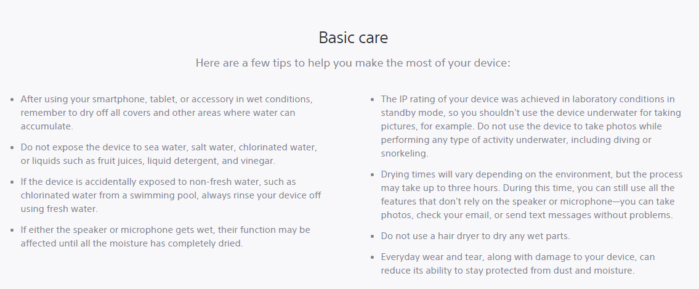
As you can see, lab conditions are usually pretty different from real-world conditions. Tests are always performed in freshwater. This rules out a lot of real-world water conditions, such as salt water at the beach, chlorinated water in a pool, or a spilled soft drink. Tests usually involve a phone on standby or even turned off, so you can forget about using your phone underwater. Your touchscreen likely won’t really work anyway. Sony even mentions that you should let your phone’s microphone speakers dry entirely for up to three hours before attempting to use them.
On top of that, the IP rating only tells you how protected your phone is against dust particles and pure water. And not how protected it is against other environmental factors, such as extreme temperatures. Unless your phone has also passed military standards for extreme conditions. MILSTD-810G, like the Samsung Galaxy S7, you should avoid dropping into scalding liquids like a hot tub.
What can I do with a Phone that is Rated IP53
The HTC 10 and the Google Pixel both have an IP rating of IP53. This means these devices are protected against dust, so dust might get inside. But it won’t compromise their inner workings or against spraying water with no pressure when tilted up to a 60-degree angle. Here’s what that means for you.
IP53 means you can use your phone by the side of the pool, but you should treat it like a non-waterproof phone. Don’t let it fall in!
- Dropping your phone in the water will not stop it from working. However, dust might get inside the phone, including under the screen, and be annoying to look at.
- Getting caught in a light rainstorm should be okay. The phone is protected against light sprays even when held at a 60-degree angle. So, if you’re holding it in your hand in a normal position, you should probably put it away sooner rather than later. The IP53 test only requires 10 minutes of spraying water, so these phones aren’t designed to be used in the rain.
- If you spill a glass of water on your phone, it will probably be okay. But you must take the same precautions when spilling water on a regular phone. Turn it off and let it air-dry thoroughly before turning it on again.
IP65/68
Many of Sony’s Xperia phones are rated IP65/68. Which is actually better than just being rated IP68. Officially, these phones are dust-proof and protected against two types of water damage, low-pressure jets and total immersion in 1.5 meters for up to 30 minutes.
Most non-waterproof phones will survive a little rain, but you shouldn’t regularly use your phone in the rain like this unless it’s IP65.
- Drop your phone in the water all you want, and your phone won’t sustain any damage and should remain functional.
- A rainstorm is the least of your worries. You should be fine even in a reasonably heavy downpour. You might even be able to take your phone in the shower though I’m not sure why you’d want to.
- In most liquid-related accidents spilling water on your phone or dropping it in the pool are no problem. If you drop your phone in a liquid that’s not fresh water, you should rinse it off with fresh water before setting it aside to dry.
- You’re probably okay to use your phone underwater, provided you’re in freshwater, not chlorinated or salt water. Sony even suggests taking photos underwater on its Xperia Z3v product page.
- The IP68 rating says nothing about temperature, so you should avoid dropping your phone in hot liquid, a hot tub, a bath, or a pot of soup.
IP68
Samsung’s Galaxy S7, S7 Edge, and S7 Active all have a rating of IP68. Officially, these phones are similar to the IP65/68-rated phones, but they might lack protection against low-pressure water jets.
Dropping your phone in the ocean is fine if it’s IP68, but you should rinse it off in freshwater before letting it dry.
- If your phone is pelted by heavy rainfall, there might be some damage.
- You should not take this phone in the shower. But again, why would you want to?
- While your phone can be immersed in up to 1.5 meters of fresh water for up to 30 minutes, you might want to avoid dropping it in moving water, such as rivers or currents of water.
You’ll see IP67 on a lot of phones, too. That’s very similar to IP68, except that IP67 means up to one meter. IP68 means more than one meter of water submersion. That more than one meter bit could mean 1.5 meters, or it could mean 10 meters. Only the manufacturer will tell you. Best not to drop either one in the deep end. Generally, only devices like rugged sports watches or diving electronics can take pressure more than a few meters in water. So try not to drop your phone in the deep end.
